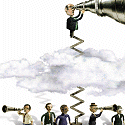To the Cloud and Beyond
In this virtual roundtable, our panel of experts weighs in on the evolution of worldware: from the desktop software of two decades ago, to today's Web 2.0 and social 'cloud' technologies, and on to the discipline-specific tools of the future.
 Co-moderator Gary Brown: The concept of 'worldware' is now almost 20 years old. How did it start, and what were some of its key characteristics? As the one who coined this term, why don't you give us your perspective, Steve?
Co-moderator Gary Brown: The concept of 'worldware' is now almost 20 years old. How did it start, and what were some of its key characteristics? As the one who coined this term, why don't you give us your perspective, Steve?
Steve Ehrmann: The concept of worldware came out of what was an Educom study. [Editor's note: Educom merged with Cause to form Educause in 1998.] Steve Gilbert [former VP of Educom] created an Educom Software Initiative. One of its task forces focused on "valuable, viable software"-- the question of what sorts of software were having an impact on education. Mostly, we were looking at software that had been developed for educational purposes. But we also looked at some software that was not specifically developed for education but that was used for education, among other things-- such as word processing software-- and for those types of tools I later coined the term "worldware."
Moderators: Gary Brown and Nils Peterson, Washington State University.
Panelists: Steve Ehrmann, The TLT Group; Colleen Carmean, Arizona State University; Phillip D. Long, University of Queensland (Australia) and MIT.
Yet, as we wrote our case studies and analyzed them, we noticed that the worldware cases were having a greater impact on education nationally than the courseware cases were. That's because worldware had some real advantages: It was much more likely to be known in advance to the students and to the teachers. And it was much more likely to be seen as legitimate-- the students and teachers could see that it was valued in the larger world. Academic users might not need to have as much training to use worldware in courses, because they might already know how to use it. Or, if they did need training, it might be only in the instructional specifics for a particular assignment. Then, too, there was the amortization of costs. A large market was paying for worldware, so the cost per user to develop, market, support, maintain, and upgrade worldware typically was low while the cost per user for courseware was usually high. Another big advantage: If a vendor went out of business, another vendor might come in and be able to run the files that had run on the previous vendor's software. These were all potentially significant advantages.
Co-moderator Nils Peterson: What's now the most important thing for the higher education community to recognize about worldware, especially in light of the current environment with cloud computing and Web 2.0 technologies?
Colleen Carmean:We have reached a world where our technology of choice, Web 2.0, is not on the desktop-- rather, it is in the cloud. So now, we can say that worldware 2.0 is where the desktop meets the cloud, given the social technologies that we are all using all the time in our lives, and in our way of being in the world. For me, worldware 2.0 is the sum of all those social technologies that have crept into every part of my life. Stemming from this, perhaps the most important thing about worldware today is that we are realizing the power of "We greater than Me." It makes me wonder: Is it evolutionary for us as people that we are using these technologies to redefine ourselves as interconnected communities?
 Colleen Carmean is a digital knowledge architect for the College of Public Programs at Arizona State University's Downtown Phoenix campus. Her responsibilities include strategic planning for adoption of new learning environments, both online and emergent. She teaches critical thinking and applied computing courses, and conducts research on enterprise knowledge capture in complex environments.
Colleen Carmean is a digital knowledge architect for the College of Public Programs at Arizona State University's Downtown Phoenix campus. Her responsibilities include strategic planning for adoption of new learning environments, both online and emergent. She teaches critical thinking and applied computing courses, and conducts research on enterprise knowledge capture in complex environments.
 Gary Brown directs the Center for Teaching, Learning, and Technology at Washington State University. He has been the lead developer of WSU's Critical Thinking Project and is currently working with the team coordinated by the American Association of Colleges and Universities on its ePortfolio assessment initiative.
Gary Brown directs the Center for Teaching, Learning, and Technology at Washington State University. He has been the lead developer of WSU's Critical Thinking Project and is currently working with the team coordinated by the American Association of Colleges and Universities on its ePortfolio assessment initiative.
 Steve Ehrmann has helped pioneers of educational uses of technology since the late 1970s, when he began a 20-year career fostering innovation. He founded the award-winning Flashlight Program in 1992. Since 1998, he has been vice president of The TLT Group, a nonprofit organization that supports, and is supported by, 150 higher ed institutions around the world.
Steve Ehrmann has helped pioneers of educational uses of technology since the late 1970s, when he began a 20-year career fostering innovation. He founded the award-winning Flashlight Program in 1992. Since 1998, he has been vice president of The TLT Group, a nonprofit organization that supports, and is supported by, 150 higher ed institutions around the world.
 Phillip D. Long is a professor at the University of Queensland (Australia) and director of the university's Center for Educational Innovation and Technology. He also is a visiting researcher at MIT's Center for Educational Computing Initiatives and a New Media Consortium board member.
Phillip D. Long is a professor at the University of Queensland (Australia) and director of the university's Center for Educational Innovation and Technology. He also is a visiting researcher at MIT's Center for Educational Computing Initiatives and a New Media Consortium board member.
 Nils Peterson is assistant director of the Center for Teaching, Learning, and Technology at Washington State University. He also is project manager for the university portal, myWSU, and is leading an effort to re-envision the university's learning management systems.
Nils Peterson is assistant director of the Center for Teaching, Learning, and Technology at Washington State University. He also is project manager for the university portal, myWSU, and is leading an effort to re-envision the university's learning management systems.
Peterson: Has education kept up with worldware 2.0; with this evolution? What is happening in the classroom?
Carmean: Teachers and students have kept up as individuals, in that they are using and embracing these technologies. But in higher ed we are finding it very difficult to figure out how to apply [these technologies] in the curriculum. Even though we all use Wikipedia, and we Google, and we have our Google reader, and we look at Facebook, and we Twitter, and we Furl and find out who's bookmarking what... Even so, when we go into Biology 101, it's very difficult to change how we've done everything in the past. It's still hard for the teacher, for example, to say, "I'm dividing up my students into groups of five and they are not turning in individual assignments; instead, they are turning in one paper for the five of them. And they are collaborating and pursuing consensus and sharing their references with me via RefWorks..."
It's interesting that we are having an easier job of it at the institutional level by, for instance, aligning ourselves with Google for Gmail, or maybe with Vimeo for streaming video. These are successful enterprise efforts, but what are we communicating to our students in the classroom? There, we really have not yet met the cloud.
Brown: Going forward, how will worldware change, especially with respect to academic issues?
Phillip Long: We have to think carefully about what problem we are trying to address. Tools that have been described as worldware are addressing the simplification and efficiency of some shared activities, independent of discipline. For example, you normally wouldn't use an Excel spreadsheet to create art, but you might find a spreadsheet an effective way to track your department's art supplies. By and large, with worldware now, we are only trying to address some fundamental, commonly shared issues.
Similarly, a significant attribute of Web 2.0 tools is that they are simply trying to engage and deal with the issue of how to be more bi-directionally interactive. For example, in the past, you did things one-way: The web was something you read; it wasn't something you wrote. Now, all of a sudden, wikis allow us to write to it. And for a large variety of Web 2.0 tools, an underlying theme is the leveraging of sociality that had been absent from digital networked communications and now is being introduced in very powerful ways.
That's all terrific. But ultimately, at the end of the day, if what we are doing is trying to leverage learning so that we cultivate and develop citizens who can be productive knowledge workers in different areas, setting about to solve problems of society, we have to get beyond the simple ability to interact and communicate easily and efficiently with each other. We need to have tools to solve problems that have specific foci. That's why we'll begin to develop "disciplineware," which, alongside other worldware, will leverage Web 2.0 technologies and the cloud. This is especially relevant for those who are in the business of training and pursuing knowledge creation as a profession.
Peterson: That sounds great, Phil, but is this just a futurist, pie-in-the-sky type of thing? How will the rise of disciplineware come about?
Long: The average academic laborers have five or six courses to teach per semester, plus thousands of papers to read, and hundreds of e-mails to write every day. How could they get past all that and have time for disciplineware? There is no easy answer to that, but there is a need to take up some of the creative experimentation that's already going on to some degree across most campuses. And we need to approach disciplineware in the same scholarly fashion that we do in the knowledge-creation side of our work.
"At the institutional level, we are aligning ourselves with Google for Gmail, or Vimeo for streaming video. But what are we communicating to our students in the classroom? There, we have not yet met the cloud." -- Colleen Carmean, Arizona State
Brown: Do you see a distinction between disciplineware and what we might call "schoolware," where schoolware is only applied in academia, and disciplineware is aligned with something that's relevant in the professional world?
Long: Whatever you call them, the differentiation between the two has long been far too pronounced. What happens in school and what happens in the practice of becoming a professional should, in fact, be much more convergent and overlapping. There's an artificiality that we've induced over time, in part because we had large numbers of students and we didn't have any other mechanical way to deal with that. It forced a process that made content king and continually reinforced that position. But now we can and should evolve beyond that.
::WEBEXTRAS ::
The Future of Web 2.0: Learning technology strategist Gary Brown charts the course from CLEs and ePortfolios, to PLEs and worldware.
Viewpoint: Can Campus IT Outsource to Web 2.0?